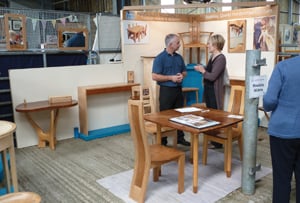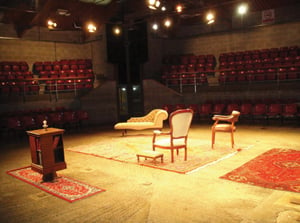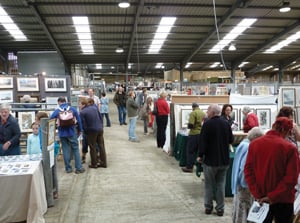Until the cows come home
Cattle market by day, theatre by night: Anthea Rathlin-Jones on making art in the spaces available



Skipton boasts the only theatre in a livestock market in Europe. This not-for-profit venue is only six years old and has already played host to famous comedians and musicians. The Mart Theatre has now established itself as an important venue for the region. The first Foot and Mouth crisis left CCM Auctions empty for nigh on a year. They had to look at ways of using the site other than for livestock sales but still maintain it for farmers. The main sales ring had been used by Northern Broadsides, and given that there was no professional theatre in Skipton, Craven District Council and the CCM Auctions Board agreed to engage with the arts as part of the development on site.
So how does it work practically – an auction mart by day, a theatre by night? How does the site turn from a livestock venue into a space for the arts? Can the two mix and sit side by side, with completely different operating agendas? There are obvious differences between agriculture and the arts, but it is fair to say that there is a clear understanding of how each conducts their business. It was vital to establish and respect the boundaries of this working relationship to make sure each could operate their respective programmes. However this is still a developing project so there will always be areas to negotiate. It is very clearly a livestock site first, and the theatre and events work around that. This means theatre happens mainly on Fridays and Saturdays. However, with more than one livestock sale ring there are further opportunities when the main ring/theatre space can’t be used. It is vital to keep track of the sales calendar and to ensure communication channels are open. So, for weekends, the livestock ring and rostra get taken out, the area is swilled down, and the section stage and backdrop are put in. Voila – a theatre space!
Clearly there are differences between delivering an arts programme and delivering a livestock programme. One of the major factors is dressing room spaces, and, yes, there is a certain aroma in the air! The facilities of a traditional theatre are just not available. The boardroom becomes a dressing room, and although it is a large room, it does not sit near the stage area. There is no link to the stage for artists, and when entering and exiting they have to leave via the bar area, cross the corridor and try to get out as quickly as possible before the audience arrive.
There is no wing space, cross over or proscenium arch. There are two entrances from the main corridor that can be used as stage entrances and also, using the corridor, two side entrances that are by the stage. Crossovers mean performers run from one exit around the corridor to the other entrance. It can work.
Smell? Yes there is always an aroma but then it is a livestock auctioning mart. The Mart Theatre has never been sold as anything else and it is this that masks the smell. Marketing it as it is is the key. It is an unusual space, so make the most of it. We do, of course, do our best to make sure disinfectant is used and that the corridor and entrances are clean. And then there are the livestock pens. Swilled down, this huge area is used for a variety of events. Some are agricultural but the main art event is Art in the Pen. This annual art fair has developed into one of the North’s major contemporary art fairs. Artists take a ‘pen’ and set up a stall to sell their work direct to the public. In 2010, we has 8,000 visitors who bought £79,000 of art work across the two days.
There have been some significant achievements and successes. Just starting something from nothing in a strange environment, and getting to the stage of having the theatre recognised as a major cultural resource in the area and on the promoter’s radar, is an achievement. And as the project progresses, it has now its own umbrella organisation, Skipton & Craven Culture Company, and is developing a strong outreach programme. Like many arts organisations there are financial limitations, and with two members of staff there has to be a hands-on approach to the delivery of the programme. The reward is the positive feedback from the audiences.
Join the Discussion
You must be logged in to post a comment.